Thursday, August 30th, 2007
Harris Interactive, a marketing firm that researches issues affecting today’s youth, recently released findings from a new survey examining when parents introduce their young children to the Internet.
Findings for children six or younger:
- 41% of adults ages 18 and older introduced at least one child to the Internet at the age of six or younger
- 53% of females ages 18 – 34 introduced at least one child to the Internet at the age of six or younger
Findings for children three or younger:
- 20% of adults ages 18 and older introduced at least one child to the Internet at the age of three or younger
- 25% of females ages 18 and older introduced at least one child to the Internet at the age of three or younger
- 15% of males ages 18 and older introduced at least one child to the Internet at the age of three or younger
- 28% of females ages 18 – 34 and older introduced at least one child to the Internet at the age of three or younger
This survey was conducted in June 2007. 2, 246 adults aged 18 and older were surveyed online. From that number, 549 adults responded that they had children under the age of 18 living in their household. It was from these 549 respondents that these survey results were compiled.
Whether you agree with this survey’s findings or not, you can’t ignore the fact that children are indeed being introduced to computers and the Internet at a very young age. The number of young computer users is growing. However, be aware that even content that claims to be specifically developed for any young audience may not be what’s right for your child. Here are a few tips for parents:
- Be an informed media consumer for your child. Find reviews about the sites your child wishes to visit. Spend time checking out these sites on your own. Get familiar with the content you’re putting in front of your child.
- Set some time limits for your child. Computer use in moderation for young users is the best approach.
- Visiting sites that use internal links tend to be better than those that don’t. What does this mean? Sometimes children’s websites include links to other websites, usually through ads. When clicked, these ads can take your child away from the site you wish them to stay on. In a research report conducted in 2002, it was discovered that young children can’t tell the difference between a site’s content areas and an ad, so be mindful of sites that include advertisements.
- Spend time with your child while they explore online. Many teachable moments will present themselves and it provides a much more rewarding experience for both parent and child together!


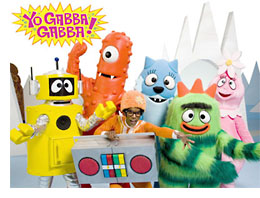 The long awaited debut of
The long awaited debut of 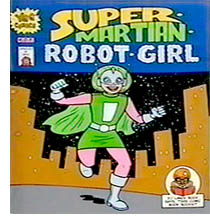 The first season of Yo Gabba Gabba will include 20 episodes. Much like any new show, it takes some time to hit your stride and find that natural beat. The first few shows are good; some parts are stronger than others in their appeal, but an improvement in show quality can be seen from episode to episode. The second show, themed “Summer”, is very entertaining. The performance by the band The Aquabats with their song “Pool Party” has made me an instant fan of the group. A segment called “Cool Tricks” where kids (and sometimes adults) show off a unique skill they have learned, and a re-occuring animation segment called “Super Martian Robot Girl” are also very entertaining. I thought this show was good, and then I saw the fourth episode called “Dance”. It was just plain rockin’ with great rap music, a “red-light, green-light” approach to dancing for youngsters, and striking video effects that made me feel like going out to a the dance club! I’ve seen a wonderful progression in the quality of music over this short span of shows and am eagerly awaiting more of the same with shows yet to air.
The first season of Yo Gabba Gabba will include 20 episodes. Much like any new show, it takes some time to hit your stride and find that natural beat. The first few shows are good; some parts are stronger than others in their appeal, but an improvement in show quality can be seen from episode to episode. The second show, themed “Summer”, is very entertaining. The performance by the band The Aquabats with their song “Pool Party” has made me an instant fan of the group. A segment called “Cool Tricks” where kids (and sometimes adults) show off a unique skill they have learned, and a re-occuring animation segment called “Super Martian Robot Girl” are also very entertaining. I thought this show was good, and then I saw the fourth episode called “Dance”. It was just plain rockin’ with great rap music, a “red-light, green-light” approach to dancing for youngsters, and striking video effects that made me feel like going out to a the dance club! I’ve seen a wonderful progression in the quality of music over this short span of shows and am eagerly awaiting more of the same with shows yet to air.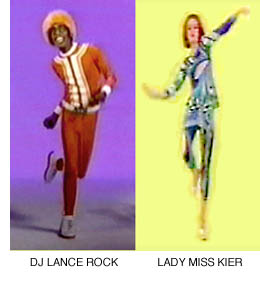 Whether intentional or not, you can see many other influences on the show. The main sets and some of the characters found in Yo Gabba Gabba have a
Whether intentional or not, you can see many other influences on the show. The main sets and some of the characters found in Yo Gabba Gabba have a 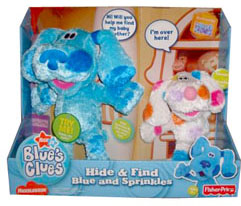 I’ve been wondering when RFID would begin to take a hold in the toy market. RFID is a technology that takes advantage of small wireless computer chips that have the ability to talk to one another. One way of thinking about the technology is that if a shirt had an RFID tag in it, whenever you dropped off the shirt at a dry cleaner, the radio frequencies emitted by the tag would alert some other computer in the store; it would know instantly who you are and how you would like your shirt laundered without ever saying a word to anyone. RFID allows any two (or more) items embedded with the technology to know about each other, and know how far away they are from each other. RFID used within toy products has the wonderful ability to work with the way children naturally play, and also offers new and imaginative enhanced play opportunities. Imagine a toy house complete with furniture, different dolls of family members, pets and vehicles that all could be electronically aware of each other. As the dog approaches the boy doll, the boy could speak the dog’s name. As a car drives up to the house, its headlights could turn on. As the mommy doll enters the front door, it could speak “Kids, I’m home!”
I’ve been wondering when RFID would begin to take a hold in the toy market. RFID is a technology that takes advantage of small wireless computer chips that have the ability to talk to one another. One way of thinking about the technology is that if a shirt had an RFID tag in it, whenever you dropped off the shirt at a dry cleaner, the radio frequencies emitted by the tag would alert some other computer in the store; it would know instantly who you are and how you would like your shirt laundered without ever saying a word to anyone. RFID allows any two (or more) items embedded with the technology to know about each other, and know how far away they are from each other. RFID used within toy products has the wonderful ability to work with the way children naturally play, and also offers new and imaginative enhanced play opportunities. Imagine a toy house complete with furniture, different dolls of family members, pets and vehicles that all could be electronically aware of each other. As the dog approaches the boy doll, the boy could speak the dog’s name. As a car drives up to the house, its headlights could turn on. As the mommy doll enters the front door, it could speak “Kids, I’m home!”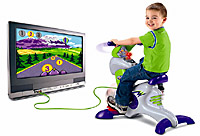 There was much buzz at Toy Fair with the announcement of this toy and rightly so. The Smart Cycle is a TV-based plug-and-play, cartridge-based platform that looks a like a cross between an exercycle for preschoolers and a
There was much buzz at Toy Fair with the announcement of this toy and rightly so. The Smart Cycle is a TV-based plug-and-play, cartridge-based platform that looks a like a cross between an exercycle for preschoolers and a  Here are two new plug-and-play products to come out of Radica, a cool tech toy company now owned by
Here are two new plug-and-play products to come out of Radica, a cool tech toy company now owned by  Hyper Dash is a technology toy that could be used indoors or out and does not require a television or computer to use. To start the game, 5 colored electronic targets are placed around the house or yard. Then, holding a talking electronic “tagger”, spoken instructions are given to the child, like find the blue target, then the red, etc. There are different game settings that focus on math skills, team work, and timed-based searches. As a child successfully finds the requested target, the music, pace, and complexity of each new request increases. This toy is recommended for children ages 5 – 8.
Hyper Dash is a technology toy that could be used indoors or out and does not require a television or computer to use. To start the game, 5 colored electronic targets are placed around the house or yard. Then, holding a talking electronic “tagger”, spoken instructions are given to the child, like find the blue target, then the red, etc. There are different game settings that focus on math skills, team work, and timed-based searches. As a child successfully finds the requested target, the music, pace, and complexity of each new request increases. This toy is recommended for children ages 5 – 8.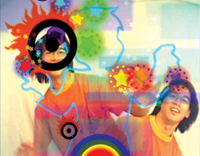 The company TikTokTech was showing two different stand alone TV plug-and-play devices. A small camera unit is placed on top of your television to play either music games or a combination of music and art games, depending on which device you purchase. While motion-based products have really only been around for a short while, these are the only titles available that provide a freeform artistic or musical experience for kids. For those that follow motion-based games, I strongly recommend checking out the
The company TikTokTech was showing two different stand alone TV plug-and-play devices. A small camera unit is placed on top of your television to play either music games or a combination of music and art games, depending on which device you purchase. While motion-based products have really only been around for a short while, these are the only titles available that provide a freeform artistic or musical experience for kids. For those that follow motion-based games, I strongly recommend checking out the